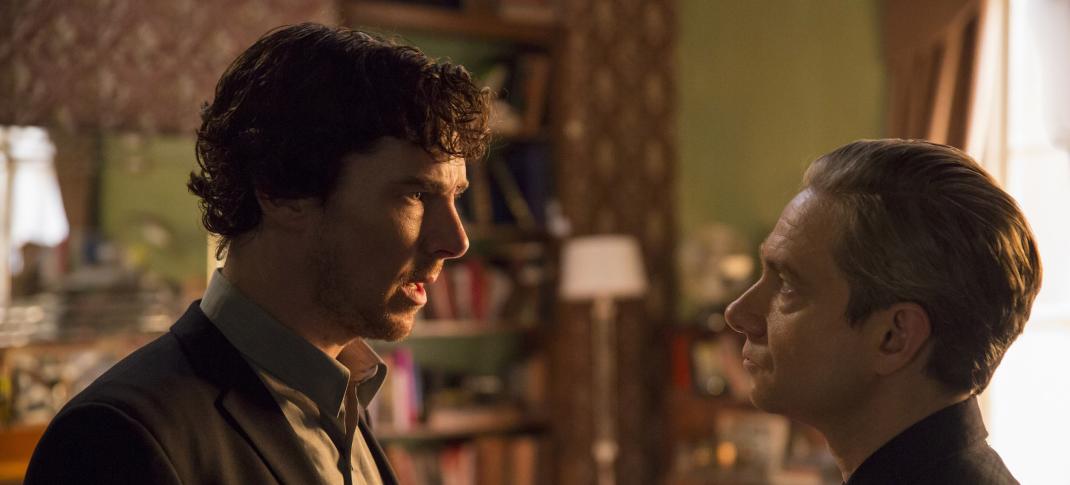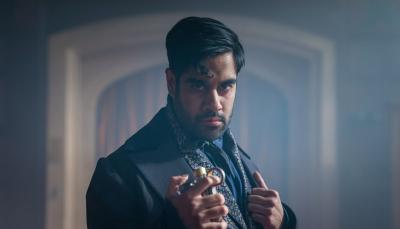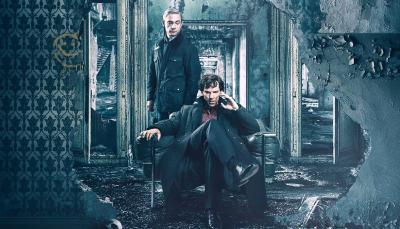'Sherlock' Season 4: 'The Lying Detective' Recap

Benedict Cumberbatch and Martin Freeman in "Sherlock" Season 4
(Photo: Courtesy of Ollie Upton/Hartswood Films & MASTERPIECE)
Previously on Sherlock: Sherlock and John investigate a case involving shattered busts of former British Prime Minister Margaret Thatcher. It turns out to be connected to Mary’s shady past as a killer for hire, and she ultimately ends up being killed by a bullet meant for Sherlock. John blames his best friend for his wife’s death, and is clearly transferring some anger that should be more accurately directed at himself, since he’s been having an affair. For more info, check out last week’s recap here.
“The Lying Detective” is a really great episode from a character perspective – both Sherlock and John are given some great moments, together and separately, and it actually feels as though there are consequences from last week played out in a realistic way. As a story, it’s entirely too convoluted in places and Toby Jones could probably build a house from the scenery he chews through in every one of its scenes. Oh, and the twist at the end is…weird. Perhaps it’s one of those things that we won’t be able to fully judge until the end of next week’s episode, but on first impression: it’s real weird.
This episode is loosely based on the Sir Arthur Conan Doyle episode “The Dying Detective”, in which he fakes a terminal illness to entrap Culverton Smith. If you’re at all familiar with it, some of tonight’s twists were easy to guess, but since they were largely based on character motivations rather than plot necessity for once, it’s an easy sin to forgive.
This is a Weird Beginning. Anyway, on with it. John is back in therapy following Mary’s death. John Watson seems like the kind of person that should maybe always be in therapy, but he particularly needs it right now because he is both seeing and conversing with a vision of his dead wife. He tells Dr. Whoever, that he’s not sleeping, he’s palming his child off on friends all the time, and that he hasn’t been seeing Sherlock because he’s holed up in his flat and won’t come out. Of course that’s precisely when an Aston Marton pursued by police pulls up outside.
Elsewhere, Toby Jones is evilly looking out over the Thames like a Bond villain, so ta-da Culverton Smith has arrived. He’s hosting what looks like a board meeting with a roomful of people and laughing maniacally and going on about how the most dangerous thing you can do to someone you care about is tell them your darkest secret because it exposes your heart to them – you can’t take it un-say it if they decide they don’t like it. You can’t close your heart after it’s opened.
He then has everyone given an IV of some kind of memory drug that will keep them from remembering what happens. He wants to tell them all something – he wants to kill someone – and he wants to tell them about it first. Why on earth anyone would ever do this is up for grabs, I expect. We see Faith afterward, hazy and confused, trying to write down a handful of identifying words on a notepad. Culverton Smith appears to take the note away from her, claiming that it’s for her own good.
Sherlock Gets a New Case. It turns out that scene was three years ago, and Faith has now gone to Sherlock at Baker Street with the news that her father wants to commit murder. Only she doesn’t remember who he’s promised to kill. For his part, Sherlock looks terrible. He’s sweating and unkempt and clearly on a truckload of drugs. Even his deductions are kind of a mess – they’re still correct, but they’re sloppy and all over the place. He’s fairly uninterested in Faith’s story, until he is, and launches off a bunch of rapid-fire deductions about her mental state and her plan to commit suicide. They decide to go for chips.
The two end up spending most of the night together, wandering through London while Sherlock performs various bits of deduction about Faith’s living situation, her friends and relationship with her father. Sherlock finally decides to take her case because she said something impossible, that her life turned on a single word, the name of the person dear old dad wanted to kill. He says he no one has names that are a single word unless you’re like Elvis or Napoleon, so he’s intrigued. (To me this seems weird, because it could easily also be the name of a place or a thing that was meant to signify a person, but I’m not a great detective what do I know.)
Sherlock then takes her gun as payment and throws it into the river, after giving her a touching speech about the value of life and the evils of suicide because “taking your life” is a thing that you do to someone else. (If this were about him finally processing what he put John through after “The Reichenbach Fall” but the flashes of the London Aquarium imply that its really all about Mary. Unfortunate.) At this point Sherlock starts screaming and losing touch with reality and when he finally comes back to himself he’s alone and the bench Faith was sitting on is empty. Is Sherlock in the middle of an overdose? Was Faith even real? What is happening?
Oh and somehow in the middle of all this, Sherlock figures out that Culverton Smith is a serial killer. Welp, why not, I guess?

Time for a Three Week Time Jump! It’s three weeks later and we’re back to the car chase from earlier with the cops. But it’s not Sherlock driving like we thought, it’s Mrs. Hudson. She’s come to track down John because Sherlock has become the biggest hot mess in the world. He’s shooting the walls at Baker Street and yelling Henry V speeches loudly. The walls are covered with photos of Culverton Smith, along with string and newspaper articles. It’s all very Rust Cohle on a bender in True Detective. So, Mrs. Hudson has done the only thing she could do – kidnapped Sherlock and brought him to John in the boot of her car so he can examine him. She is a straight up legend. John – and Molly – take a look at Sherlock and determine that he’s basically killing himself with drugs. Sherlock knows this, especially because he set it all up, weeks ago, by predicting everything John would do. (And he’s as obnoxious as you’d expect explaining it.)
In the midst of all this, they get a call from Culverton Smith, who’s sending a car for them. He, John and Sherlock have a meeting, which Sherlock had also set up, weeks ago. Sherlock smugs out, but not before admitting that Mrs. Hudson was right, and he needs John’s help because he’s pretty much destroying himself with drugs. But that doesn’t mean that Smith isn’t a killer and the most despicable person he’s ever met, either. John looks like the least excited ever, but agrees to go with Sherlock.
Sherlock’s Breakdown is Approaching Next Level Territory. Sherlock and John go to meet with Culverton Smith. Sherlock, it turns out, has tweeted something about his theory that Smith is a serial killer, so it’s kind of awkward. Smith, however, takes it in stride, and treats Sherlock’s accusation as a joke to boost in one of his new ads for breakfast cereal. (He’s a “cereal killer” really, get it?) The three awkwardly talk, and then Smith takes the two on a tour of a local hospital that he has pretty much paid for himself. (He has a wing there.)
Sherlock and Smith play their verbal weird cat and mouse game for awhile until they have a full on confrontation in the hospital’s mortuary. They discuss serial killers, and murder and all manner of things, until Sherlock tries to get Faith Smith to confront her father about his evil plans. This dramatic moment goes awry when the woman he summons to confront her father turns out to be Faith Smith, but not the same woman that he met before. Sherlock wants to know who came to his flat then – and when he can’t figure it out he spirals further and further into crazy. He steals a scalpel and threatens Smith with it, and tells him to stop his creepy laughing, which I think we can all get behind. The problem is, is that Smith isn’t laughing, and Sherlock tries to stab him, and John has to fight him to prevent it. Then John beats the living crap out of Sherlock, so much so that he has to be pulled off of him by hospital security. John’s character this season is wild, y’all. I mean, I get that he’s angry at Sherlock, that however unfair the fact that he blames him for Mary’s death is, it’s how he feels, and on some level that’s understandable. But him literally kicking Sherlock while he’s down? Really?

John Catches a Clue. John heads back to Baker Street where he has an awkward confrontation with Mycroft and Mrs. Hudson. John clues in to the fact that there’s a third Holmes brother out there somewhere, and Mrs. Hudson enlightens everyone to some truths about Sherlock’s character. The upshot of all this, is that they discover the “just in case I die” DVD that Mary left for Sherlock, and John watches it.
Elsewhere, Sherlock is admitted to Culverton Smith’s hospital and put in his “favorite room”. Why? So Smith can sneak in during the night through an unknown secret door and murder him. As we watch Smith model latex gloves and discuss his plans to murder Sherlock with Sherlock, John’s busy watching Mary’s video. It turns out that his best friend’s violent and elaborate spiral down into the depths of drug addiction was part of an elaborate ruse – both to lay a trap for a bad man, and to give John something to do. Per Mary’s explanation, John will never let anyone help him, so Sherlock has to give him someone to save, so that he can, in turn, save himself. Sherlock, unsurprisingly, has offered himself.
It’s not surprising then, that John arrives at the hospital just as Smith is attempting to smother Sherlock. And it’s also not surprising that Sherlock had a hidden recording device, which he used to tape Smith’s rather lengthy and enthusiastic confession of murder.
There’s kind of a lot going on in this sequence that involves literally everyone treating John like a child, instead of a person with agency who is capable of growth and self-awareness, but okay. I guess we have to go with this?
Time for an Emotional Moment. Back at Baker Street, Sherlock tells John everything as the Mary hallucination helpfully provides commentary. Sherlock is still kind of confused about the fact that he apparently hallucinated a fake version of Culverton Smith’s daughter, so that’s kind of weird. He wonders if the drugs maybe opened doors in his mind or something.
Anyway, thanks to the prodding of ghost Mary, the two actually manage to talk out their issues for what is most likely the first time in their lives. John tells Sherlock that he knows that Sherlock didn’t kill Mary, that she made her own choices, and chose to save his life. Sherlock talks about how he’s struggling with the fact that Mary’s decision to save his life has conveyed a significance on it that he doesn’t know how to process. John says it is what it is, and is about to leave when Sherlock gets a text message with a moan notification that indicates its from Irene Adler. John tells him that he should text her back because having love in his life would complete him as a person. He proceeds to give Sherlock a speech about how life is short and he needs to grab love where he can find it because it’ll all be gone before you can blink. In the midst of this, John starts crying, and Sherlock hugs him, and it’s possibly the most legit emotional moment this show has featured since that phone call right before Sherlock threw himself off of a building.
Surprise, There’s One More Twist. Just in case the fact that Sherlock plotted an elaborate ruse that involved him falling back into hardcore drug addiction for John’s sake wasn’t enough of a surprise? The episode’s not quite done yet. Because of course it turns out that John’s therapist isn’t exactly who we thought she was. It turns out that she’s some kind of crazy master of disguise, and she’s also the woman who showed up at Baker Street claiming to be Faith Smith. And she’s also also the woman John met on the bus and was having an affair with. But that’s not all. She’s also the secret Holmes sibling. Who is a sister instead of a brother.
Yes, really. It turns out that she’s a woman named Euros Holmes, because her parents “liked weird names”. And she’s pretended to be John’s therapist all this time, ostensibly to get information on her brothers, but also to whip out a gun and shoot John at close range. Ummmm. See you next week, I guess?
Faith is Euros is Bus Lady, Oh My. It’s hard to know what exactly to make of this Faith is John’s Mistress is Actually Sherlock’s Sister twist. This is a nice call back to the moment from “A Study in Pink,” where we all (including Sherlock) thought that John was talking about his brother Harry, when in actuality he meant his sister Harriett instead. This is the kind of narrative symmetry that makes a certain kind of sense, in the broadest sort of way.
However, the revelation that Euros is Faith is Bus Lady requires some significant suspension of disbelief. Are we really meant to believe that Euros’ disguises – which pretty much seemed to boil down to various frumpy wigs and a cane – were so good that they could fool both John and, more importantly, Sherlock? If we can manage to believe that John spent multiple therapy sessions with this woman and didn’t’ recognize her as the same person he wanted to have an affair with, that’s one thing. But we’re also supposed to swallow the idea that Sherlock spent an entire night with his own sister and didn’t recognize her? Sherlock? The man we’ve had to watch deduce the smallest and most devastating personal details about perfect strangers for years? I guess his particular brand of heroin must be really intense.
The real question now is whether Euros is the “secret sibling” Mycroft kept referring to, or if she’s an additional Holmes we didn’t know about. Theoretically, Euros COULD be Sherrinford. “Sherlock” is a middle name after all, and “Euros” could be hers. Or there could also be four Holmes kids. (That line about people always stop counting after three feels kind of like it might be a hint?) Who even knows. And there’s also the prospect that Euros connects to the Moriarty video that we (again) learned nothing new about. There are so many questions that I still have, and only one episode left to get any answers.
And additionally, I have to wonder – again – how these Holmes kids are all offspring of that totally nice, normal, well-adjusted couple we met back in Season 3. Are they secretly the world’s worst parents? Were all three Holmes kids left on their doorstep in baskets? Given the way the two elder Holmeses were presented – as, generally, being perfect, loving and role models of stable marriage – it feels unfathomable that they would raise not one, not two but THREE children who are as clearly emotionally damaged as these folks are. Goodness.
Well, next week is the season finale, so maybe we’ll finally get some answers, huh? Or maybe not. What do you all think?




